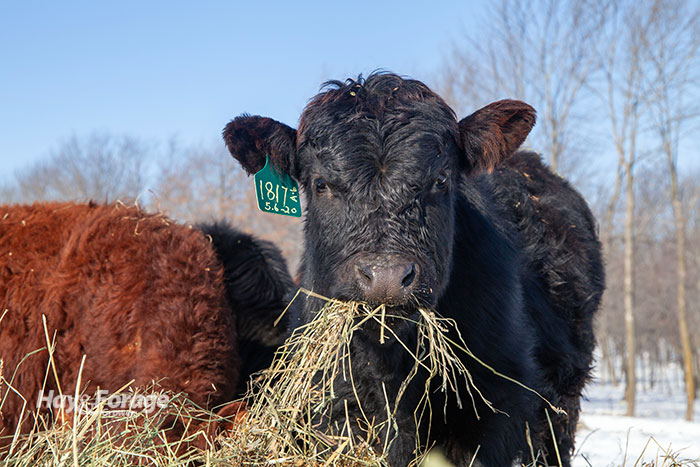
Extension specialists from North Dakota State University (NDSU) encourage farmers who plan to bale graze during late fall and winter to begin placing bales where they will be needed. Moving bales from the hayfield directly to a staging area adjacent to where they will be fed or, if possible, within the pasture can save time, fuel, and labor this winter.
“The concept of bale grazing is simple,” says James Rogers, a NDSU Extension forage specialist. “Place bales in a grid pattern in the area where they will be fed. Then, install electric fence in a manner to allow access for two to three days of feeding. Continue to allow two to three days of bale feeding by leapfrogging the electric fence across the bale-grazing area.”
Bale grazing is a system that is gaining in popularity throughout the Northern and Central regions of the U.S. If done properly, the labor-saving practice reduces manure handling and spreads nutrients and organic matter across pastures. “Those areas and paddocks in need of the most fertility can be targeted,” notes Mary Keena, an extension livestock environmental management specialist with NDSU.
The NDSU specialists offer the following suggestions to make bale grazing successful:
Consider how many bales will be needed. This is determined by nutritional demand, the number of head, and the desired length of time for bale grazing. For example, the 90-day period after weaning can be an optimal situation for bale grazing because it is a time of low nutritional demand for the cow, which can be met by fair- to good-quality hay.
Factor in bale waste. Rogers says a good estimate for bale waste is 20%, but it will vary depending on the area used for bale grazing, bale density and quality, bale access space, and animal behavior.
Forage test each hay lot. A hay lot is defined as similar species harvested from the same hayfield within 48 hours. Allocate hay based on nutrient content and nutritional demand. Stage bales based on quality and leave higher quality hay for cows in late gestation or early lactation.
Select the areas to be bale grazed. Bale grazing can be done on introduced perennial pasture, hayfields, or crop ground, but the effects on each will differ. Bale grazing creates a concentration of nutrients and hoof action around each bale. These effects require consideration when choosing the area to bale graze. Select an area that will benefit the most from the addition of nutrients.
Perennial pasture areas with sod-forming grasses will hold up better than bunch-type grasses. Avoid areas where excess nutrients can flow into streams and ponds. Areas that can provide natural wind protection are advantageous.
Use multiple locations for bale grazing over time. This will help reduce nutrient concentration in one area. Soil test to monitor changes in fertility over time.
Hay bales move nutrients and seed from one location to another. If hay is contaminated with weed seed, such as foxtail barley, be mindful of areas where you do not want the weed to establish.
Place bales where all cattle can have equal access. Setting up bales on a 40-by-40-foot grid will work well and can lead to more uniform manure distribution.
Have a fencing and water plan. Electric fencing provides the flexibility to make bale grazing work. Two strands of hot wire may be required to prevent cattle from pushing into future ungrazed bales. If cattle have no experience with electric fence, train them to it prior to turning onto the bale-grazing area. Make sure that cattle have easy and adequate access to water.

